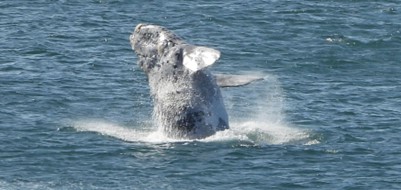OUT TO LUNCH
On Friday 22nd September I drove along Clarence Drive en route to Betty’s Bay. My wife was visiting a friend who lives there and I had promised to make myself scarce for a few hours while they chatted and caught up with all the news.
Winter in the Western Cape this year has tested the patience of most residents. When September arrived after a particularly wet and cold June, July and August I thought the worst would be over and the temperatures would suddenly warm up as they had done for the past ten years. But it was not to be. The days barely got above 14C with a couple of rare sunny days thrown in just to tease us. I had lunch outdoors with friends at a wine farm on one day when the temperature actually reached 32C. Two days later we were back to more rain, cloudy skies and 14C.
The 22nd September wasn’t particularly warm but the clouds had cleared and the sky was blue so it seemed a perfect day for whale watching. So, camera and binoculars packed, the plan was to drop off Mrs B at Betty’s Bay, drive on past Hermanus and Stanford to De Kelders and watch whales.
The drive along the R44 (or Clarence Drive as it is better known) between Gordon’s Bay and Rooi Els is probably one of the most spectacular coastal drives in the world. So much so that Rolls Royce chose the route for the international launch of the Rolls Royce Dawn a few years ago. The problem with international launches is that many of the visiting motoring journalists are more used to driving on the right side of the road. So a narrow winding coastal road where you are expected to drive on the left of the road can prove something of a challenge. I am told that there were some scary moments but that no Rolls Royce Dawns were actually harmed during the launch.___STEADY_PAYWALL___
We arrived at Betty’s Bay in good time and after I dropped off Mrs B I carried on through Kleinmond, Hermanus and past Stanford before turning off to De Kelders. There is an enormous road upgrade taking place between Stanford and Gansbaai. So there were plenty of earth moving vehicles and massive piles of soil on the sides of the road. It’s a huge undertaking but not a particularly surprising sight for those of us who are used to Western Cape efficiency.
Since it had taken just over an hour to drive from Betty’s Bay and was almost lunch time I decided to stop off at ‘Coffee on the Rocks’, a favourite of mine, take up a seat outside on the verandah and look for whales. I wasn’t disappointed. Other whale spotters were already at an adjoining table (they also happened to be ‘Out to Lunch’ fans) and we got chatting. They had spotted a school of dolphins earlier but there were whales a’plenty breaching and lobtailing just a few hundred metres away, near to the coast. It was a magnificent sight so I ordered lunch and kept the camera at the ready.
It is a well known fact among photographers that if you keep your camera steady and focussed on the last place a whale was spotted then, after a lengthy period of nothing happening, you will eventually tire or want a sip of wine and put the camera down. Only then will a whale leap out of the ocean in what would have been a perfect shot. Thank heavens for digital cameras because I would have got through several rolls of film photographing bits of empty sea. I managed to get one half decent shot….the other 150 or so I deleted.

After lunch I reluctantly bade my new friends farewell and drove back to Betty’s Bay to collect my wife just after 3pm. Then we had another glorious trip along Clarence Drive with the afternoon sun sparkling on the sea and happy campers arriving early for the long weekend at Kogel Bay Resort.
Two days later very little of what I have just described still existed. Rockfalls and landslides on Clarence Drive have made that road impossible to use and it seems as though it will remain so for quite some time. It had only just been repaired from earlier rains but the damage this time around seems far more severe. Heaven knows what happened to the campers at Kogel Bay Resort because no tent could have withstood the wind and rain on Sunday 24th September.
Not only was Clarence Drive impossible to use but the only other road out of Rooi Els, Pringle Bay and Betty’s Bay via Kleinmond was also impassable after the swollen Palmiet River partially destroyed the bridge on the road to Hermanus. An added woe was no access to water or electricity which meant that cell phone connectivity was also a problem.
Since very few people still have landlines this is now the only way we can reach emergency services. However, the Betty’s Bay community pulled together, dealing calmly with a couple of medical emergencies and concentrating on restoring essential services.
Councillors and mayors were visible and involved with rescue and restoration (a sharp contrast to what happens up in Gauteng) and I understand that the same has been happening in most if not all the affected areas. By tuesday the broken bridge at Kleinmond had been sufficiently repaired to allow limited traffic.
The devastation in Hermanus was bad enough for them to have to cancel the Whale Weekend. Part of the cliff walk has been washed away and the municipality was also without without power and water. Stanford was badly affected with homes flooded and a visibly choked up Peter Bruce appeared on eNCA to describe how the normally placid Klein River had become a raging torrent which had caused so much destruction. He said that Stanford had received more than 100mm of rain.
However, worst hit appears to have been Franschhoek which received at least 300mm of rain in two days and, in one part of the town, 400mm was measured. Various aerial videos taken by drones have appeared and the entire town appears to have been affected. So much so that access to Franschhoek was impossible last week. The Franschhoek pass is very severely damaged and will take a lot of money and some very complex engineering work before it reopens.
One very upmarket guest house was so badly flooded that the water roared in through the rear door of a glorious Cape Dutch building, destroyed all the carefully curated art and antique furniture in the way and smashed out again through the front door of the building just off the main road in Dirkie Uys Street. The prize winning garden at the back and the pool are now buried under metres of wet mud and the collection of classic cars lovingly acquired by the owners over the years which were displayed in an adjoining building are also destroyed.
The aerial shots reveal enormous damage to homes and businesses on the lower Franschhoek Pass as one enters the town. It’s virtually impossible to identify which buildings might have been affected because many of them are completely buried in mud. Both water and electricity were still out when I spoke to friends in the town last Friday and the clean up operation had started.
The tragedy of all this, apart from the damage to people’s homes and businesses and the loss of life (miraculously low given the appalling weather) is that this is the beginning of the tourist season.
Nobody who has driven into a normally pristine Franschhoek on a sunny summer's day can fail to have been impressed by the place. Even on a chilly autumn day during the Franschhoek Literary Festival the town still has immense charm. But there’s a lot of work to be done to restore that charm after the storm damage.
There’s also the loss of crops and vines to consider as well as the many businesses that rely on a few months of summer foreign tourism to cover the year’s lean months. The lack of access along the Franschhoek Pass means that a journey to either bring things into the town or to export them now involves a long and expensive detour. The knock on effects of this flooding will only become apparent in the months to come.
Then there are the more practical considerations of repair. There are so many damaged buildings that there surely cannot be enough artisans to go round. As if that isn’t bad enough, top end property prices in the worst affected areas are also likely to drop. This is the second major flood in three months and insurance companies will understandably be reluctant to offer cover unless the premium is absurdly high. For many this is literally a case of paradise lost.
It really is a nightmare scenario but this is the Western Cape and the enormous mopping up operation is already well underway and near normal service will almost certainly be resumed under the DA. Contrast this with Johannesburg where buildings regularly catch fire; those in charge show no interest in doing anything more than drawing their salaries and voting themselves perks, and are more concerned with renaming roads after people with very dubious histories than with serving their constituents. I know where I would rather live.

